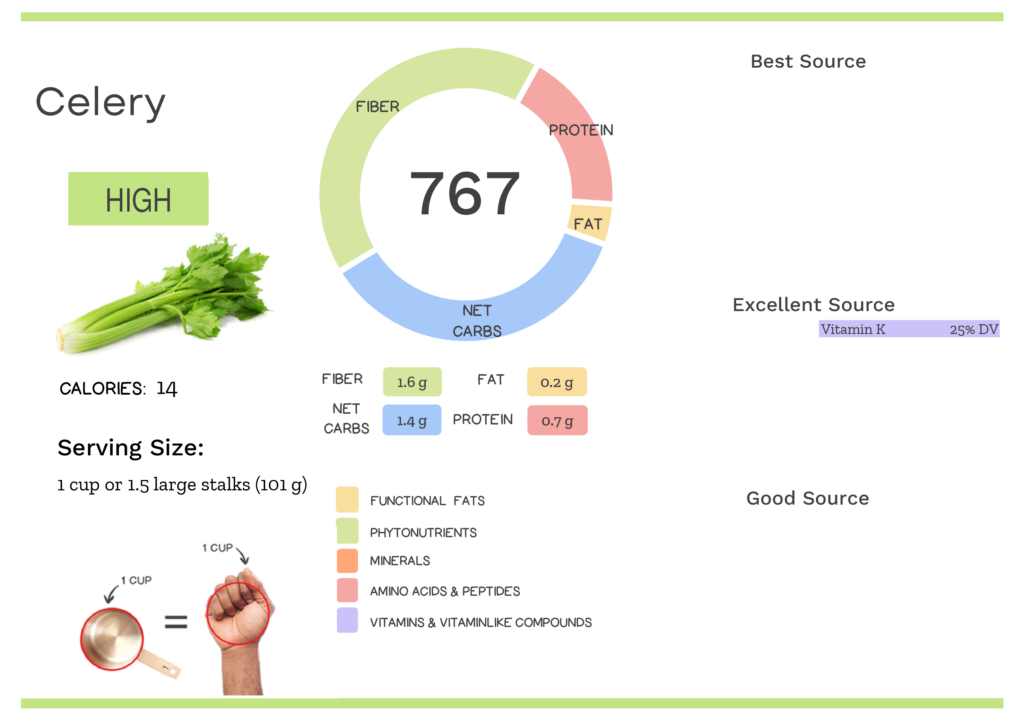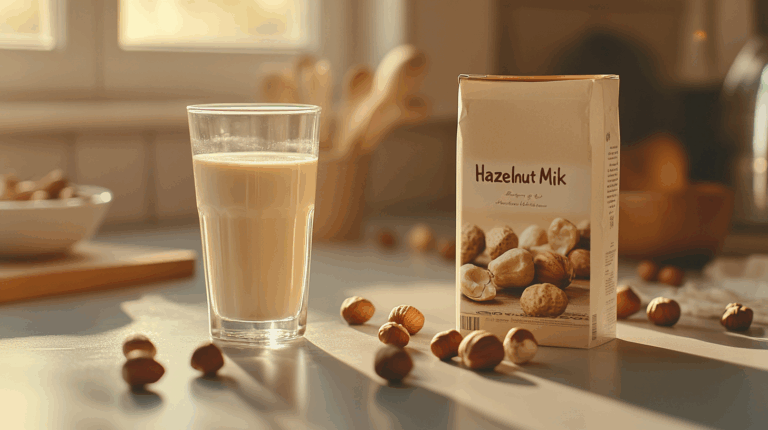The Unassuming Architect of Wellness: Unpacking the Key Vitamins and Nutrients in Celery
In the bustling symphony of superfoods, where exotic berries and vibrant greens often steal the spotlight, one humble stalk consistently plays a vital, yet often underestimated, role: celery. Often relegated to the side of a buffalo wing platter, or chopped unceremoniously into a mirepoix, celery’s crisp texture and subtle flavor belie a profound nutritional depth. It’s not just a vehicle for peanut butter or a low-calorie crunch; it is, in fact, a miniature architectural marvel, meticulously constructed with an array of vitamins, minerals, and potent phytochemicals designed to support human health.
This isn’t merely a list of ingredients; it’s a story of synergy, a narrative of how a simple plant can contribute so meaningfully to our well-being. For the knowledgeable palate and inquisitive mind, let us embark on a comprehensive journey to uncover the hidden treasures within each verdant stalk, from its hydrating core to its potent, often-discarded leaves.
The Foundation: Water, Fiber, and a Whisper of Calories
Before we delve into the microscopic marvels, it’s crucial to acknowledge celery’s macroscopic contributions, which lay the groundwork for its subsequent benefits.
1. The Hydration Hero: Water Content
Celery is famously composed of approximately 95% water. In an era where chronic dehydration is a silent epidemic, incorporating water-rich foods like celery offers a delicious and efficient way to bolster our fluid intake. This isn’t just about quenching thirst; adequate hydration is fundamental to every physiological process – nutrient transport, waste elimination, temperature regulation, joint lubrication, and maintaining the elasticity of skin and tissues. It acts as the universal solvent, facilitating the chemical reactions that sustain life. The water in celery, unlike plain tap water, comes intertwined with electrolytes, making it a more holistic hydrating package.
2. The Gut’s Best Friend: Dietary Fiber
While celery might seem light and airy, its characteristic crunch is a testament to its significant fiber content. A single large stalk can provide around 1.6 grams of dietary fiber, a blend of both soluble and insoluble types.
- Insoluble Fiber: This is the structural backbone of celery. It adds bulk to stool, promoting regular bowel movements and preventing constipation. By accelerating the passage of food through the digestive tract, it helps to "sweep" the colon clean, potentially reducing the risk of diverticular disease and certain cancers.
- Soluble Fiber: Though present in smaller amounts, soluble fiber forms a gel-like substance in the digestive tract. This slows down digestion, which helps stabilize blood sugar levels by moderating the absorption of glucose. It also acts as a prebiotic, nourishing beneficial gut bacteria. A thriving gut microbiome is linked to improved immunity, mood regulation, and even enhanced nutrient absorption.
3. The Calorie Conundrum: Debunking the Myth
Celery’s extremely low-calorie count (around 10 calories per large stalk) has earned it the infamous moniker of "negative calorie food." While the idea of expending more calories to chew and digest something than it provides is a myth, celery remains an excellent choice for weight management. Its high water and fiber content contribute to satiety, helping you feel full without consuming excess calories. It’s a smart snack that supports energy balance and helps manage cravings.
The Microscopic Marvels: A Deep Dive into Celery’s Vitamins
Moving beyond its foundational elements, celery truly shines in its diverse array of vitamins, each playing a critical, often synergistic, role in maintaining our health.
1. Vitamin K (Phylloquinone): The Bone Builder and Blood Clotter
Celery is an exceptional source of Vitamin K1 (phylloquinone), providing a substantial percentage of the daily recommended intake in just a few stalks. Vitamin K is a fat-soluble vitamin renowned for two primary functions:
- Blood Coagulation: It is indispensable for the synthesis of several proteins involved in blood clotting, preventing excessive bleeding. Without adequate Vitamin K, the body’s ability to heal wounds and stop internal bleeding would be severely compromised.
- Bone Health: Less recognized but equally crucial is Vitamin K’s role in bone metabolism. It activates osteocalcin, a protein that helps integrate calcium into the bone matrix, thereby strengthening bones and potentially reducing the risk of fractures and osteoporosis. This synergy with calcium and Vitamin D makes celery a silent contributor to skeletal integrity.
2. Vitamin A (as Beta-Carotene): The Visionary Antioxidant
While celery doesn’t contain preformed Vitamin A, it is rich in beta-carotene, a powerful carotenoid and a precursor to Vitamin A. Our bodies can convert beta-carotene into the active form of Vitamin A (retinol) as needed.
- Vision: Vitamin A is critical for maintaining healthy eyesight, particularly in low-light conditions. It’s a component of rhodopsin, a protein in the eyes that absorbs light.
- Immune Function: It plays a pivotal role in the development and function of various immune cells, enhancing the body’s defense against infections.
- Skin Health: Vitamin A supports cell growth and differentiation, contributing to healthy skin and mucous membranes.
- Antioxidant Power: Beta-carotene itself is a potent antioxidant, neutralizing free radicals that can damage cells and contribute to chronic diseases like heart disease and certain cancers.
3. Vitamin C (Ascorbic Acid): The Immune Booster and Collagen Synthesizer
Though not as famous as oranges for its Vitamin C content, celery offers a respectable amount of this water-soluble powerhouse.
- Antioxidant Defense: Vitamin C is a powerful antioxidant, protecting cells from oxidative stress and inflammation.
- Immune System Support: It is crucial for the proper functioning of the immune system, stimulating the production and activity of white blood cells.
- Collagen Synthesis: Vitamin C is essential for the synthesis of collagen, the main structural protein in connective tissues, skin, bones, and blood vessels. This contributes to wound healing, skin elasticity, and structural integrity throughout the body.
- Iron Absorption: It significantly enhances the absorption of non-heme iron (iron from plant sources), making it a valuable addition to vegetarian and vegan diets.
4. Folate (Vitamin B9): The Cellular Architect
Celery contains a good supply of folate, a B vitamin critical for numerous bodily functions.
- DNA Synthesis and Repair: Folate is essential for cell division and the synthesis and repair of DNA and RNA, making it particularly important during periods of rapid growth, such as pregnancy and infancy.
- Red Blood Cell Formation: It is vital for the production of healthy red blood cells, preventing megaloblastic anemia.
- Homocysteine Metabolism: Folate, along with B6 and B12, helps to metabolize homocysteine, an amino acid whose elevated levels are associated with an increased risk of cardiovascular disease.
5. Other B Vitamins (B6, Riboflavin): The Energy Catalysts
While in smaller quantities, celery also contributes to our intake of other B vitamins like Vitamin B6 (pyridoxine) and Riboflavin (B2). These vitamins are coenzymes, meaning they help facilitate numerous enzymatic reactions crucial for energy metabolism, converting food into usable energy, and supporting neurological function. Riboflavin, for instance, is vital for cellular respiration and antioxidant protection.
The Mineral Matrix: Earth’s Gifts in Every Stalk
Beyond vitamins, celery’s mineral profile further solidifies its status as a nutritional gem.
1. Potassium: The Electrolyte Maestro
Celery is a significant source of potassium, a crucial electrolyte that plays a central role in maintaining fluid balance, nerve signaling, and muscle contractions.
- Blood Pressure Regulation: Potassium is perhaps best known for its role in counteracting the effects of sodium, helping to relax blood vessel walls and lower blood pressure. This makes celery a heart-healthy food, contributing to cardiovascular wellness.
- Fluid Balance: It works in tandem with sodium to maintain the delicate balance of fluids inside and outside cells.
- Nerve and Muscle Function: Potassium is essential for the proper transmission of nerve impulses and for the contraction of muscles, including the heart muscle.
2. Calcium: Beyond Dairy
While not in quantities comparable to dairy products, celery provides a modest yet bioavailable amount of calcium. This mineral is fundamental for:
- Bone and Teeth Health: The primary structural component of bones and teeth.
- Muscle Contraction: Essential for muscle movement, including the heartbeat.
- Nerve Transmission: Plays a role in signaling between nerve cells.
- Blood Clotting: Involved in the complex cascade of blood coagulation.
3. Magnesium: The Unsung Cofactor
Celery offers a respectable amount of magnesium, a mineral involved in over 300 biochemical reactions in the body.
- Energy Production: Crucial for ATP (adenosine triphosphate) synthesis, the body’s main energy currency.
- Muscle and Nerve Function: Supports proper muscle contraction and nerve impulse transmission.
- Blood Sugar Control: Helps regulate blood glucose levels.
- Bone Health: Contributes to bone mineral density.
4. Sodium: Nature’s Balance
Interestingly, celery contains a small amount of natural sodium. Far from being detrimental, this natural sodium, balanced by its high potassium content, contributes to its slightly salty flavor and supports electrolyte balance, especially when consumed after exercise or in hot climates. It’s a far cry from the processed sodium found in many packaged foods.
5. Manganese: The Antioxidant Enzyme Activator
Celery also provides manganese, a trace mineral vital for several enzymatic functions.
- Antioxidant Defense: It is a key component of superoxide dismutase (SOD), one of the body’s most powerful antioxidant enzymes, which protects mitochondria from oxidative damage.
- Bone Formation: Involved in bone development and maintenance.
- Metabolism: Plays a role in the metabolism of carbohydrates, amino acids, and cholesterol.
The Phytochemical Frontier: Celery’s Unsung Heroes
Beyond the established vitamins and minerals, celery’s true depth lies in its vast and complex array of phytochemicals – bioactive plant compounds that contribute significantly to its therapeutic properties. These are the true storytellers, weaving tales of cellular protection and systemic harmony.
1. Flavonoids (Apigenin, Luteolin): The Anti-Inflammatory Powerhouses
Celery is particularly rich in flavonoids, a class of polyphenols known for their potent antioxidant and anti-inflammatory properties.
- Apigenin: This specific flavonoid has been extensively studied for its anti-cancer potential, ability to reduce inflammation, and even its calming effects on the nervous system. It has shown promise in modulating cell signaling pathways involved in tumor growth and metastasis.
- Luteolin: Another powerful flavonoid, luteolin, also exhibits significant anti-inflammatory, antioxidant, and anti-cancer effects. It can inhibit inflammatory enzymes and suppress the production of pro-inflammatory cytokines.
2. Phenolic Acids (Caffeic Acid, Ferulic Acid): Cellular Defenders
These organic acids are robust antioxidants found in celery. They help scavenge free radicals, protect DNA from damage, and contribute to the plant’s overall protective capabilities against oxidative stress. Ferulic acid, in particular, has garnered attention for its potential neuroprotective effects.
3. Phthalides (Butylphthalide): The Blood Pressure Whisperers
Unique to celery, phthalides like 3-n-butylphthalide (3nB) are responsible for celery’s characteristic aroma and much of its documented health benefits, particularly related to cardiovascular health.
- Vasodilation: Phthalides have been shown to relax the smooth muscles around blood vessels, leading to vasodilation and a reduction in blood pressure. This natural hypotensive effect makes celery a valuable dietary tool for managing hypertension.
- Cholesterol Reduction: Some research suggests phthalides may also help reduce levels of "bad" LDL cholesterol.
- Neurological Benefits: Emerging research indicates that phthalides might have neuroprotective properties, potentially supporting brain health and cognitive function.
4. Coumarins: Beyond the Antioxidant Veil
Celery contains various coumarins, compounds that also possess antioxidant and anti-inflammatory properties. Some coumarins have been investigated for their potential to enhance the activity of white blood cells and support detoxification pathways in the liver.
5. Polyacetylenes (Falcarinol, Falcarindiol): The Anti-Cancer Allies
These compounds are increasingly being recognized for their potent anti-inflammatory and potential anti-cancer effects. While found in various vegetables, their presence in celery adds another layer to its disease-fighting arsenal. They are believed to inhibit the growth of certain cancer cells and protect against carcinogens.
The Holistic Health Story: Connecting the Dots
When we view celery not as a collection of individual components but as an integrated system, its holistic health benefits become strikingly clear.
- Cardiovascular Health: The synergistic action of potassium, phthalides, fiber, and antioxidants works in concert to support a healthy heart. They help regulate blood pressure, reduce cholesterol, and protect blood vessels from oxidative damage.
- Digestive Harmony: The high water and fiber content are fundamental for maintaining a healthy digestive tract, preventing constipation, and feeding a thriving gut microbiome. The anti-inflammatory compounds may also soothe digestive discomfort.
- Anti-Inflammatory and Antioxidant Shield: The abundant flavonoids, phenolic acids, and polyacetylenes provide a robust defense against chronic inflammation and oxidative stress, which are root causes of many modern diseases, including arthritis, diabetes, and neurodegenerative conditions.
- Bone Integrity: The combination of Vitamin K, calcium, and magnesium contributes significantly to strong bones, reducing the risk of osteoporosis.
- Immune Resilience: Vitamin C, Vitamin A (beta-carotene), and various phytochemicals bolster the immune system, enhancing the body’s ability to ward off infections and diseases.
- Weight Management: Its low-calorie, high-fiber, and high-water profile makes celery an ideal food for satiety and healthy weight maintenance.
Beyond the Stalk: Exploring All Parts of the Celery Plant
Our story often focuses on the familiar green stalks, but celery is a plant of many parts, each with its own unique nutritional narrative.
- Celery Leaves: Often discarded, the leaves of celery are actually a nutritional powerhouse, often containing higher concentrations of certain vitamins (like Vitamin A and Vitamin C) and phytochemicals than the stalks. They have a stronger, slightly bitter flavor and are excellent finely chopped into salads, added to soups, or used as a garnish.
- Celery Seeds: These tiny seeds are a concentrated source of nutrients and have been used in traditional medicine for centuries. They are particularly rich in phthalides, flavonoids, and volatile oils. Celery seed extract is often used for its diuretic, anti-inflammatory, and blood pressure-lowering properties. They can be used whole or ground as a spice.
- Celery Root (Celeriac): A different cultivar of celery, celeriac is grown for its knobby, edible root. While its nutrient profile differs somewhat from the stalks (higher in starch, lower in water), it is still a good source of fiber, Vitamin K, Vitamin C, and phosphorus. It offers an earthy, nutty flavor and can be roasted, mashed, or added to stews.
Integrating Celery into Your Culinary Story
The beauty of celery lies not just in its nutritional density but also in its versatility.
- Raw: Enjoy it as a crisp snack, dipped in hummus or nut butter. Add it to salads for crunch and freshness.
- Cooked: Incorporate it into soups, stews, stir-fries, and casseroles. It’s a foundational component of mirepoix (celery, carrots, onions), adding depth of flavor and nutrients.
- Juiced: Celery juice has gained popularity as a health tonic. While juicing removes fiber, it concentrates the vitamins, minerals, and phytochemicals, making them highly bioavailable. However, consuming whole celery ensures you get the full benefits of its dietary fiber.
- Leaves and Seeds: Don’t discard the leaves; use them as a fresh herb. Experiment with celery seeds in rubs, marinades, or homemade pickles.
Considerations:
- Organic vs. Conventional: Celery frequently appears on the Environmental Working Group’s "Dirty Dozen" list due to its porous nature and potential to absorb pesticides. Choosing organic celery is often recommended to minimize exposure.
- Storage: Store celery in the refrigerator, ideally wrapped in foil or submerged in water, to maintain its crispness and nutrient integrity.
The Encore: Celery’s Enduring Legacy
The story of celery is one of quiet strength, a testament to the profound power held within seemingly simple plant foods. It reminds us that wellness doesn’t always require exotic ingredients or complex preparations. Sometimes, the most potent elixirs for health are found in the unassuming crunch of a vegetable that has graced our tables for centuries.
From its role as a hydrating agent and a fiber-rich gut ally to its sophisticated orchestration of vitamins (K, A, C, folate, B-complex), minerals (potassium, calcium, magnesium), and an impressive array of bioactive phytochemicals (flavonoids, phthalides, coumarins), celery is truly an architectural marvel of nutrition. It’s a cardiovascular guardian, an anti-inflammatory shield, a bone strengthener, and an immune booster – all wrapped in a low-calorie, crisp package.
For the knowledgeable consumer, embracing celery is not just about adding another vegetable to the plate; it’s about acknowledging and harnessing the enduring legacy of a plant that, despite its humble demeanor, plays an extraordinary role in the grand narrative of human health and vitality. Let us give celery the recognition it so richly deserves, celebrating it not as a mere sidekick, but as a central player in our ongoing quest for comprehensive well-being.






